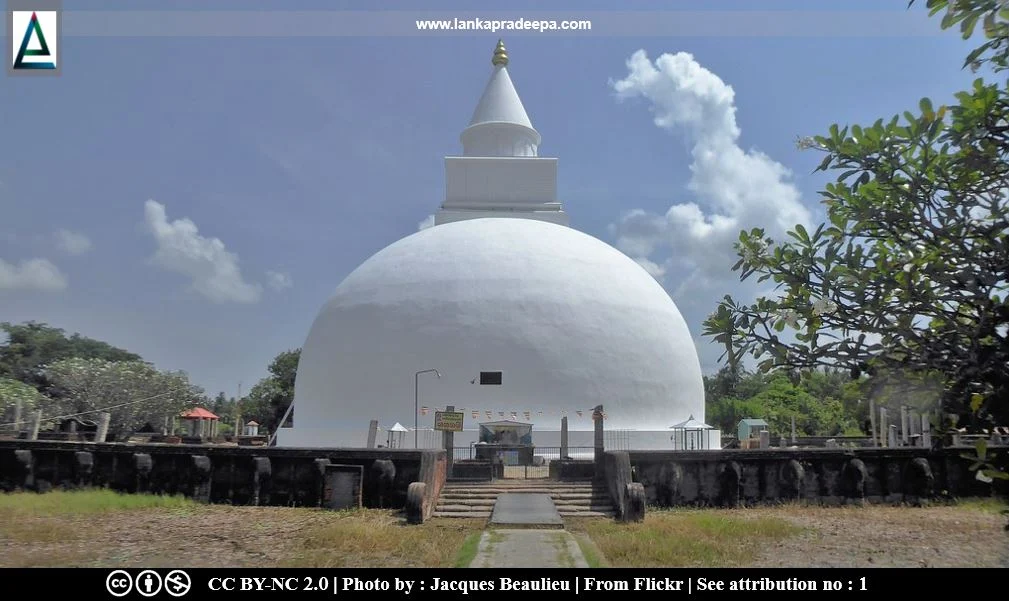
Yatala Vehera Viharaya (Sinhala: යටාල වෙහෙර) is a Buddhist temple situated in Debarawewa, near Tissamaharama in Hambantota District, Sri Lanka.
History
The ancient name of Yatala Vehera is not known (Nicholas, 1963). Three inscriptions belonging to the 6th to 7th centuries A.D. and two belonging to the 10th century A.D. have been discovered at the site (Devendra, 1956; Nicholas, 1963; Ranawella, 2005).
Locals are in believe that Yatala Vehera was built and donated to Aritta Thera by regional King Mahanaga (3rd century B.C.) as a memento of his queen giving birth to his son, Prince Yatthalakatissa, at this spot when they were fleeing from the wrath of the queen of King Devanampiyatissa (247-207 B.C.) of Anuradhapura (Abeyawardana, 2004). The chronicle Mahavamsa mentioned a temple named Yatthalaya Viharaya that was built at the place where Mahanaga's son, Yatthalakatissa, was born (Nicholas, 1963). However, according to Nicholas, the present Yatala Vehera at Tissamaharama is not the ancient Yatthalaya Viharaya that is mentioned in the chronicle (Nicholas, 1963).
The chronicle Dhatuvamsa credits the construction of Yatala Vehera Stupa to King Mahanaga (Abeyawardana, 2004).
Locals are in believe that Yatala Vehera was built and donated to Aritta Thera by regional King Mahanaga (3rd century B.C.) as a memento of his queen giving birth to his son, Prince Yatthalakatissa, at this spot when they were fleeing from the wrath of the queen of King Devanampiyatissa (247-207 B.C.) of Anuradhapura (Abeyawardana, 2004). The chronicle Mahavamsa mentioned a temple named Yatthalaya Viharaya that was built at the place where Mahanaga's son, Yatthalakatissa, was born (Nicholas, 1963). However, according to Nicholas, the present Yatala Vehera at Tissamaharama is not the ancient Yatthalaya Viharaya that is mentioned in the chronicle (Nicholas, 1963).
The chronicle Dhatuvamsa credits the construction of Yatala Vehera Stupa to King Mahanaga (Abeyawardana, 2004).
Restoration
In 1882, the then Governor of Ceylon Sir James Longden granted permission to a Buddhist monk named Ven. Tangalle Sri Jinarathana Thera to carry out the restoration works of the ruined site including the Stupa (Devendra, 1956; Uduwara, 1990). However, treasure hunters had already vandalized the Stupa before the commencement of the restoration works (Abeyawardana, 2004). After several restoration attempts, the Department of Archaeology was involved in the restoration works and accordingly, they conducted a preliminary investigation on the Stupa to gather historical evidence (Uduwara, 1990). During the excavations, bricks with Early Brahmi Scripts and four small relic caskets inlaid with semi-precious stones such as chrysoberyl, amethyst, etc. were found by them (Abeyawardana, 2004). From the investigation, it was revealed that the Yatala Vehera Stupa is a work of the 1st century A.D. and it was enlarged in the 4th century A.D. or so (Uduwara, 1990). The Stupa, in the enlargement in the 4th century A.D., had only one Pesava but during the restorations done in 1883 two more Pesavas were added to it (Uduwara, 1990).
The present Stupa is about 124 ft. tall and has a basal circumference of 340 ft. (Uduwara, 1990). A small opening has been left on the dome of the renovated Stupa to observe the different phases of construction. Due to the rise in the water table around the area, a moat has been created around the Stupa for the convenience of the excavations carried out during the recent restoration process (Abeyawardana, 2004).
Ruins
A large number of ruins of buildings with stone pillars and walls indicate that a huge monastery may have existed on this site in the past.
Eight image houses belonging to different types and periods and the retaining walls of the Stupa terrace with figures of elephants (the Eth Pawra) have been unearthed from the Yatala Vehera site (Uduwara, 1990). The Sandakada Pahan (moonstones) and Korawak Gal (wingstones) that are in the temple premises are unique and are not found elsewhere (Uduwara, 1990). Also, the Bodhisattva images and kerb-stones on which Dharani are indited reveal the Mahayana influence on the site (Uduwara, 1990). Many artefacts discovered from the site are presently on the display at the nearby Yatala Museum.
The standing statue with crossed hands
A limestone statue of the Buddha with two hands kept abreast on the chest has been discovered from Yatala Vehera (Devendra, 1956). This statue is considered special due to the rare hand posture (Mudra) it has. A few statues with similar postures have also been found in other sites in Sri Lanka, such as Gal Viharaya in Polonnaruwa, Na-Maluwa in Ritigala, and Dambulla Viharaya in Dambulla (Devendra, 1956). Scholars believe that this statue is a work from the 5th or 6th century A.D. (Abeyawardana, 2004).
On the premises of the modern monastery that is located in front of the Stupa opposite the road is an Asanaghara shrine. Measuring 5.3 m by 2.1 m, the Asana of this shrine is said to be the largest of its kind in the country (Dhammika, 2008).
Archaeological Museum
A small site museum of the Archaeological Department has been established near the
premises of Yatala Vehera. The museum is used to exhibit antiquities
recovered from the temple.
 .
.Attribution
References
1) Abeyawardana, H.A.P., 2004. Heritage of Ruhuna: Major natural,
cultural and historic sites. Colombo: The Central Bank of Sri Lanka.
ISBN: 955-575-073-4. pp.125-127.
2) Devendra, D.T., 1956. An unusual hand position in Ceylon statuary. Artibus Asiae, 19(2), pp.126-136.
3) Dhammika, B. S., 2008. Sacred Island; A Buddhist pilgrim’s guide to Sri Lanka. Buddhist Publication Society. ISBN: 978-955-24-0271-5. p.206.
4) Nicholas, C. W., 1963. Historical topography of ancient and medieval
Ceylon. Journal of the Ceylon Branch of the Royal Asiatic Society, New
Series (Vol VI). Special Number: Colombo. Royal Asiatic Society (Ceylon
Branch). pp.60-61.
5) Ranawella, S., 2005. Inscription of Ceylon. Volume V, Part
III. Department of Archaeology. ISBN: 955-91-59-57-7. pp.59-60.
6) Uduwara, J., 1990. Section V: History of the Department of Archaeology: 1970-1990.
(Editor in chief: Wijesekara, N.) Archaeological Department Centenary
(1890-1990): History of the Department of Archaeology (Vol. 1).
Commissioner of Archaeology. p.189.
Location Map
This page was last updated on 22 May 2023


